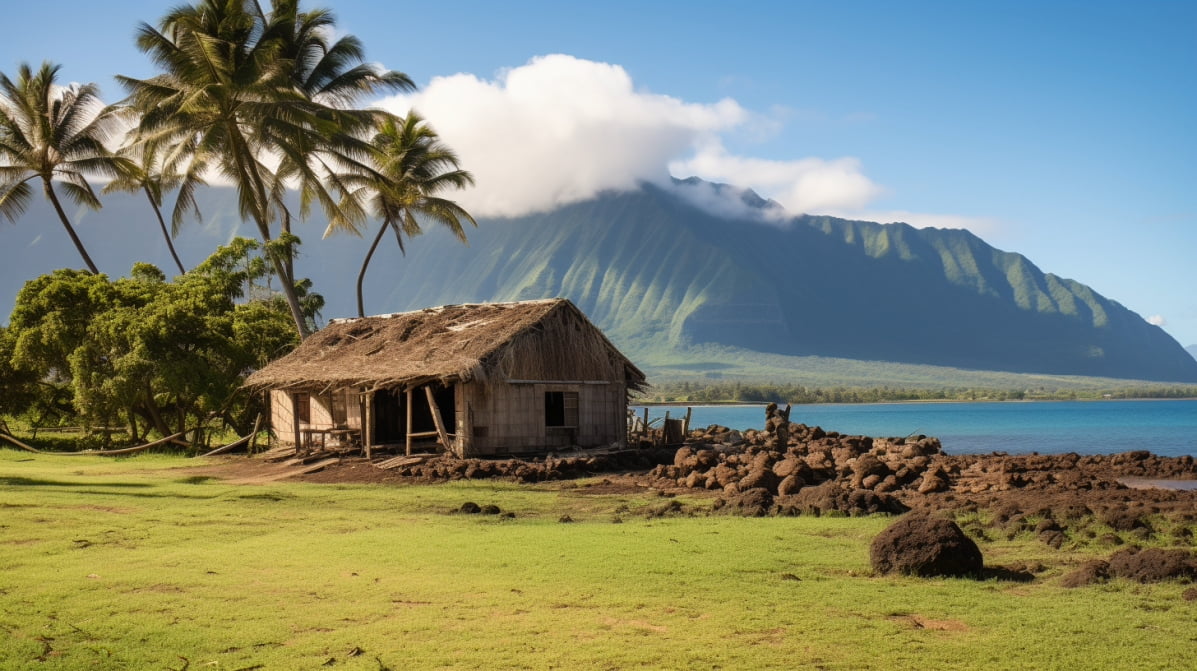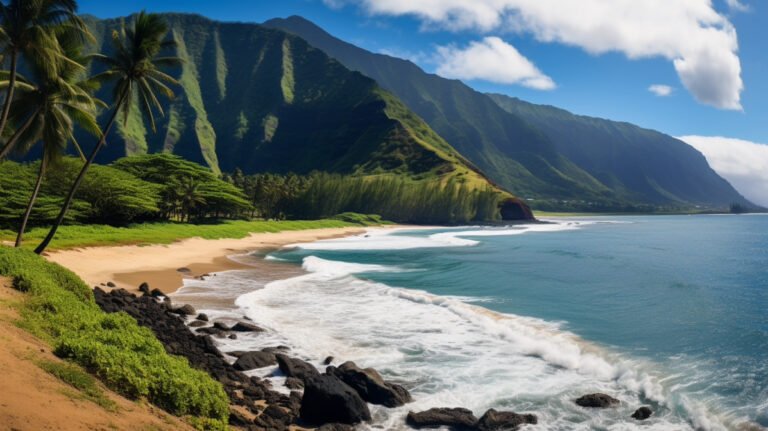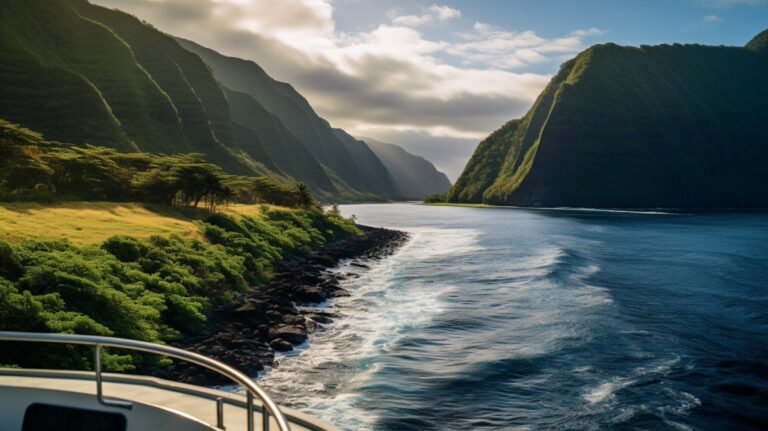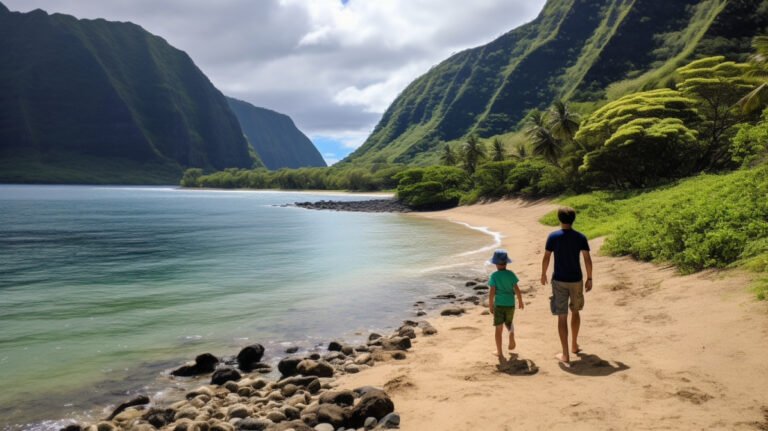Unveiling Molokai’s Historical Treasures 🌺
When people think of Hawaii, their minds often drift towards images of beaches, coconuts, and hula dancers. While all of these things are certainly a part of Hawaii’s cultural identity, there is one island that stands out for its rich history and unique stories: Molokai.
Nestled between Maui and Oahu, Molokai has long been overlooked by tourists in favor of its flashier neighbors. But those who take the time to visit this hidden gem are rewarded with a glimpse into Hawaii’s past, full of fascinating tales and cultural traditions.
From its early settlement by Polynesians to its role in preserving Hawaiian culture, Molokai is a treasure trove of history and heritage. Join us as we dive into the island’s rich past and explore its hidden treasures.
Key Takeaways:
- Molokai is a lesser-known island in Hawaii that boasts a rich history and unique stories.
- The island’s history dates back to its early settlement by Polynesians and includes the establishment of sugar plantations and the impact of World War II.
- Molokai played a significant role in preserving Hawaiian culture and traditions, contributing to music, hula, and the preservation of traditional practices.
- The island’s commitment to preserving its cultural heritage is evident in the efforts made to protect its historical sites and promote sustainable tourism.
- Molokai’s past continues to shape its present-day identity, making it a fascinating destination for history buffs and cultural enthusiasts.
Exploring Molokai’s Historical Timeline
Molokai’s history spans thousands of years and is a testament to the island’s cultural richness. From its early settlement by Polynesians to the arrival of European explorers and the establishment of sugar plantations, Molokai has undergone many changes.
Polynesians first arrived on Molokai around 650 AD and lived a simple life, relying on fishing and farming to sustain themselves. By the 16th century, Molokai had become a center for the Hawaiian kapu system, which was a complex set of social and religious laws.
European explorers first visited Molokai in the late 18th century, and in 1778, Captain James Cook arrived on the island. The arrival of Europeans marked the beginning of significant changes for the native communities on Molokai.
The 19th century brought the establishment of sugar plantations on Molokai, which brought an influx of immigrants to the island. The sugar industry boomed throughout the century, with Molokai’s sugar production reaching its peak in 1935.
World War II had a significant impact on Molokai, as the island became a key location for the military. After the war, the sugar industry continued to decline, ultimately leading to the closure of Molokai’s last sugar plantation in 1984.
Today, Molokai’s historical timeline serves as a testament to the island’s complex and multi-layered cultural heritage. From its indigenous communities to its colonial past, Molokai’s history is an essential part of its identity.
Molokai’s Cultural Heritage and Significance
Molokai has a rich cultural heritage that has been integral to shaping the island’s past and present. The island’s indigenous communities, including the Native Hawaiians, have an extensive history of living in harmony with the land and sea, which has helped sustain their way of life for generations.
The island’s cultural significance extends beyond the Hawaiian community and has played a vital role in Hawaii’s history. Molokai was the site of several significant historical events, including the arrival of Europeans in the late 18th century, the establishment of sugarcane plantations in the 19th century, and the isolation of leprosy patients in the Kalaupapa Peninsula during the 20th century.
Molokai’s Indigenous Communities and Traditions
The Native Hawaiians and other indigenous communities on Molokai have preserved their traditions, cultural practices, and connection to the land for generations. They have relied on the resources found on the island, including taro, fish, and seaweed, to sustain themselves.
The island’s cultural heritage is rooted in the traditions of hula and music, which are essential to Hawaiian culture. Molokai is home to several hula schools, which help perpetuate the practice and preserve the island’s cultural identity.
Molokai’s Role in Preserving Hawaiian History
Molokai has played a vital role in preserving Hawaiian history and cultural practices. The island’s Kalaupapa National Historical Park was established to honor the legacy of those who lived and died there. The park serves as a testament to the resilience and strength of the human spirit, and a reminder of the island’s ongoing commitment to preserving its cultural heritage.
The Molokai Museum and Cultural Center is another important site that highlights the island’s unique history. The center features exhibitions that showcase the island’s cultural heritage, including artifacts, photographs, and stories from the island’s past.
Overall, Molokai’s cultural heritage and significance cannot be overstated. The island’s indigenous communities and their traditions, along with its historical sites and landmarks, serve as a window into Hawaii’s past and a reminder of the island’s ongoing commitment to preserving its cultural identity.
Discovering Molokai’s Historical Landmarks
Molokai is home to numerous significant historical landmarks that offer insight into the island’s rich past. Whether you’re interested in the island’s indigenous communities, its more recent plantation era, or its World War II history, there is something for everyone to discover.
Kalaupapa National Historical Park
Kalaupapa National Historical Park is one of Molokai’s most notable landmarks. It was once a leper colony that was established in 1866 to isolate people with Hansen’s disease. The park is now a living testament to the strength and resilience of those who were forced to live there. Visitors can learn about the history of the colony and see the stunning natural beauty of the area, including a towering sea cliff that rises over 3,000 feet.
Molokai Museum and Cultural Center
The Molokai Museum and Cultural Center is a must-visit for anyone interested in Molokai’s history. The center provides a comprehensive overview of the island’s past and features exhibits showcasing the island’s indigenous culture, plantation era, and more. The center also offers guided tours and educational programs for visitors of all ages.
Halawa Valley
Halawa Valley is one of Molokai’s most remote locations and is home to ancient Hawaiian ruins. Visitors can explore the valley and see the beautifully restored heiau (temples) and walls that date back to pre-contact times.
St. Joseph’s Church
St. Joseph’s Church is a beautiful landmark on the island that offers a glimpse into Molokai’s religious history. The church was built in 1876 and is still in use today. Visitors can admire the stained glass windows and the unique architecture that reflects the island’s multicultural heritage.
These are just a few of the historical landmarks that you can explore on Molokai. The island’s rich history and cultural heritage are waiting to be discovered.
Unveiling Molokai’s Historical Narratives
Molokai is home to unique historical narratives that reflect the island’s rich cultural heritage. One of the most notable stories is that of Father Damien and the leper colony at Kalaupapa.
“I am one of them, and we are one in Jesus Christ,” Father Damien famously said, referring to the patients he served at the colony. For 16 years, he lived among the lepers and provided them with medical care, as well as moral and spiritual support. His efforts brought attention to the plight of those suffering from leprosy and he was canonized by the Catholic Church in 2009.”
Another significant event in Molokai’s history is the overthrow of the Hawaiian monarchy in 1893. Queen Liliuokalani, the last monarch of Hawaii, was imprisoned in a house on the island for months after the overthrow.
Other historical narratives on Molokai include the island’s role in the development of hula and the impact of early missionaries on local customs and beliefs.
Exploring these unique stories and their impact on the island’s history is an enriching experience for visitors to Molokai. It allows them to gain a deeper understanding of the island’s cultural heritage and the resilience of its people.
Exploring Molokai’s Historical Milestones
Molokai has a long and storied past, marked by significant milestones that have shaped its history. From the arrival of European explorers to the establishment of sugar plantations, these milestones have left their mark on the island and its people.
One of the most significant milestones in Molokai’s history was the arrival of the first European explorers in the late 18th century. They were followed by Christian missionaries in the early 19th century, who arrived on the island with the aim of converting the indigenous population to Christianity. The establishment of sugar plantations in the late 1800s brought about significant changes to the island’s economy and culture, with the industry dominating Molokai for almost a century.
World War II also had a significant impact on Molokai, with the island serving as an important strategic location for the United States military. After the war, the island experienced a period of transition as it adapted to the changing economic and social landscape of Hawaii in the mid-20th century.
The Preservation of Molokai’s Cultural Heritage
Today, Molokai is committed to preserving its cultural heritage and maintaining its unique identity. The island has a rich tradition of music, dance, and storytelling, and these unique cultural practices continue to thrive today.
The Molokai Museum and Cultural Center is a key resource for visitors seeking to learn more about the island’s history and cultural heritage. The center offers exhibits and educational programs that showcase the island’s unique cultural traditions, including Hawaiian language, music, and dance.
Efforts to preserve the island’s natural beauty and cultural heritage are ongoing, with a focus on sustainable tourism and community involvement in maintaining the island’s cultural identity. Molokai’s commitment to preserving its history and traditions makes it a truly special destination.
Molokai’s Influence on Hawaiian Culture
Molokai’s cultural heritage holds a significant place in Hawaiian history and has had a profound impact on the development of Hawaiian culture as a whole. The island’s isolation and unique traditions have helped to preserve a way of life that is distinct from the rest of Hawaii.
One of the most notable contributions Molokai has made to Hawaiian culture is in the realm of music. The island’s unique style of slack-key guitar playing, which involves tuning the guitar to create a distinct and melodic sound, has become synonymous with Hawaiian music. Molokai has also played an important role in the preservation of hula, a traditional dance form that is a key component of Hawaiian cultural identity.
Moreover, Molokai has been instrumental in preserving many other traditional practices, including the art of Hawaiian tattooing, or kakau. The island has several tattoo artists who specialize in this ancient technique, which involves using wooden tools to create intricate designs on the skin. Additionally, Molokai is one of the few places in Hawaii where the ancient practice of fishing with traditional nets, or throw nets, is still practiced today.
Molokai’s Commitment to Cultural Heritage
Molokai’s commitment to preserving its cultural heritage is evident in its efforts to protect and restore historical sites across the island. The Molokai Historical Society, for example, operates the Molokai Museum and Cultural Center, which houses exhibits and artifacts that showcase the island’s rich history and cultural traditions. The society also sponsors cultural events throughout the year, including hula festivals and traditional craft fairs.
Moreover, Molokai has implemented several sustainable tourism initiatives that help to preserve the island’s natural beauty and cultural identity. Many local businesses prioritize eco-friendly practices, and the island’s tourism industry places a strong emphasis on community involvement and cultural awareness.
Visitors to Molokai can engage with the island’s cultural heritage in a variety of ways, from taking hula lessons to visiting historical landmarks such as the Halawa Valley or the Kalaupapa National Historical Park. By embracing its unique history and traditions, Molokai continues to be a hidden gem that offers visitors a truly authentic Hawaiian experience.
Preserving Molokai’s Historical Sites
Molokai is home to many significant historical sites that tell the story of its rich cultural heritage. Efforts have been made to preserve and protect these sites so that future generations can learn and appreciate the island’s history.
| Site Name | Description | Preservation Efforts |
|---|---|---|
| Kalaupapa National Historical Park | This park is home to the former leper colony where Father Damien ministered to patients in the late 1800s. It’s a poignant reminder of the island’s darker history. | The park is protected by the National Park Service, which has worked to preserve the buildings and artifacts within it. Visitors can take guided tours to learn about the colony and its history. |
| Molokai Museum and Cultural Center | This museum showcases the island’s history and culture, with exhibits on traditional Hawaiian practices, plantation life, and the island’s unique flora and fauna. | The museum is operated by a nonprofit organization that is dedicated to preserving Molokai’s cultural heritage. It has a research library and hosts events and workshops to promote awareness of the island’s history. |
In addition to these sites, there are many other historical landmarks on Molokai that are worth visiting. However, it’s important to be respectful of these sites and the communities that maintain them. Visitors should follow posted guidelines and be aware of the cultural significance of what they are seeing.
Preserving Molokai’s historical sites is crucial to maintaining the island’s cultural identity. Sustainable tourism practices and community involvement are key to ensuring that the island’s history is passed down to future generations.
Molokai Today: Embracing History and Tradition
Molokai’s rich history continues to shape its present-day identity. The island’s commitment to preserving its cultural heritage is exemplified by the efforts made to maintain its historical sites, such as the Kalaupapa National Historical Park and the Molokai Museum and Cultural Center.
The island’s locals and visitors alike can engage with its history by participating in cultural activities, such as hula and traditional crafts. These experiences offer a unique glimpse into the island’s vibrant past and rich cultural traditions.
One way in which Molokai continues to embrace its history and tradition is through sustainable tourism. The island’s community has recognized the importance of protecting its cultural identity and has made efforts to promote eco-friendly tourism practices that showcase the island’s natural beauty and historical significance while minimizing its impact on the environment.
Visitors to Molokai can immerse themselves in the island’s cultural heritage by visiting historical landmarks and sites, attending cultural festivals and events, and participating in hands-on cultural activities. These experiences offer a deep understanding of the island’s history and a chance to connect with its vibrant traditions.
Molokai’s history is an essential part of its identity, and the island continues to preserve and celebrate its unique cultural heritage. As visitors explore the island, they can witness firsthand the powerful impact of history and tradition on Molokai’s present-day community.
Conclusion
In conclusion, Molokai is a hidden gem with a rich cultural heritage and compelling history just waiting to be explored. From ancient Polynesian settlements to the establishment of sugar plantations, Molokai has been shaped by diverse cultures and pivotal events. Visitors can immerse themselves in the island’s past by exploring historic sites like Kalaupapa National Historical Park and gain insight into the personal experiences that have defined Molokai.
Today, the island remains committed to preserving its traditions and embracing its unique identity through sustainable tourism and community involvement. You can participate in hula dancing, ukulele lessons, festivals, and more to experience Molokai’s living culture. There’s so much history and tradition to uncover on this often overlooked island.
We encourage you to delve deeper into Molokai’s captivating past and present culture for yourself. Download the Molokai Travel Guide Molokai Travel Guide to start planning your cultural immersion on this Hawaiian island. Let Molokai’s rich heritage come to life before your eyes.







